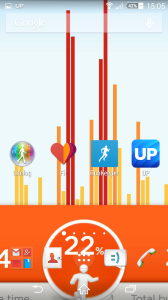The description of new media technologies as being screen-based is increasingly problematic as bodily tracking devices like fitness trackers become more common. And yet, it is hard to think of these devices as anything but media objects. While they are rather obviously reliant on mobile phones, they also mediate (ie, get in the middle) our experiences of our own bodies and the places around us like few technologies ever have.
Such devices also contribute to a growing category of cloud-based surveillance technologies that track individual use of everything from cars, to computers, to each step taken. Two University of Wollongong academics have termed this uberveillance: “omnipresent electronic surveillance facilitated by technology that makes it possible to embed surveillance devices in the human body”. Such devices include those marketed as wearable fitness trackers, but also devices like Google Glass, and small cameras such as the GoPro, which are increasingly used for personal and institutional surveillance purposes.
I’m inclined to eschew marketing-driven genre descriptions such as ‘fitness trackers’ and patented phrases such as quantified self, in favour of a more neutral and descriptive term, bodily tracking device. Let’s be clear about this: although they are marketed for their life-improving properties, these technologies are little more than surveillance bugs that keep tabs on bodily movement and function.

I originally got my bodily tracking device (a Jawbone UP 24) in the wake of significant personal illness and resultant fitness challenges. On a daily basis, the Jawbone reminds me how many steps I’ve taken, scolds me for missing targets and counts my energy intake. That’s what its supposed to do, of course and it largely does a good job.
What I’m interested in is the way it interacts with my thinking and experiences of the places around me and with my own bodily experience. Immediately upon using the object, I became more aware of how I was moving my arms when walking, I slightly reduced my food intake, and I continually check up on my sleeping patterns. Surprisingly, I feel like I sleep worse since getting the Jawbone, probably because I’m aware of just how interrupted my sleep gets some nights. This personal surveillance seems to be inducing a state of hyper-vigilance where the data itself becomes more important than the supposed end goals.
In Canada, the kind of data my Jawbone is collecting every minute of the day is being used in a court case to determine if someone’s injuries are as bad as they say. It’s conceivable such data could also be used by investigators to place people at crime scenes, or present a brief of evidence suggesting they were undertaking a particular activity at the time a crime was committed.
The aggregate data generated by these kinds of devices can also provide valuable information to authorities, as Strava’s Global Heatmap shows. If governments are deciding where to put a new cycle path, they need only open up the heatmap and compare it with their existing network to find popular routes that aren’t being serviced. But in analysing and using such data, we must be careful not to assume it truly represents the movements of a given population. Though the obvious caveat is that not everyone uses these apps, it is also true that heatmaps misrepresent urban social dynamics:
a visualization made up of routes of millions of people aggregated over months or years creates a convincing map of a city, with its major streets alight. But this “city” does not exist, because the individual traces that compose it do not temporally coexist. These traces do not correspond to any social reality actually experienced by people. As we move through a city, we do not see traces made by other people in earlier times, we do not even see our own trajectory, and others do not see our paths
An individual’s data is almost meaningless to these companies but in aggregate it becomes very valuable. And yet, at the level of the person offering up their body for surveillance, is it the aggregate or the individual about which they are concerned?
